The [2025] The Rise of Nationalism in Europe Short Notes for you is prepared by the team of Studyless.in for quick revision and memorisation.
But, this will work only if you have properly understood the chapter.
If you have not studied the chapter then please read our explanation on the rise of nationalism in europe
Table of Contents
Frédéric Sorrieu’s Vision of the World (1848)
🖼️ The Dream Painting:
- In 1848, Frédéric Sorrieu, a French artist, created 4 visual prints showing his dream of a world of democratic and social Republics.
- The first print shows:
- Men and women of all classes and ages marching in a long procession.
- They pay homage to the statue of Liberty.
- Liberty is personified as a female figure with:
- A torch (symbol of Enlightenment)
- A Charter of the Rights of Man (symbol of rights and freedom)
🏛️ Symbols and Messages:
- Broken remains of absolutist institutions lie on the ground – signifying the end of monarchy and tyranny.
- People are grouped by nations, shown through:
- National flags
- Traditional costumes
Nations in the Procession
🚩 Who’s Leading?
- United States and Switzerland – already nation-states by 1848.
- France with the Revolutionary tricolour follows them.
Germany:
- Carrying black, red, and gold flag.
- Not yet united in 1848.
- Flag symbolized liberal hopes to unite German-speaking regions.
🌍 Others in the March:
- Austria, Two Sicilies, Lombardy, Poland, England, Ireland, Hungary, Russia
👼 From the Heavens:
- Christ, saints, and angels watch the procession.
- Symbol of fraternity among nations.
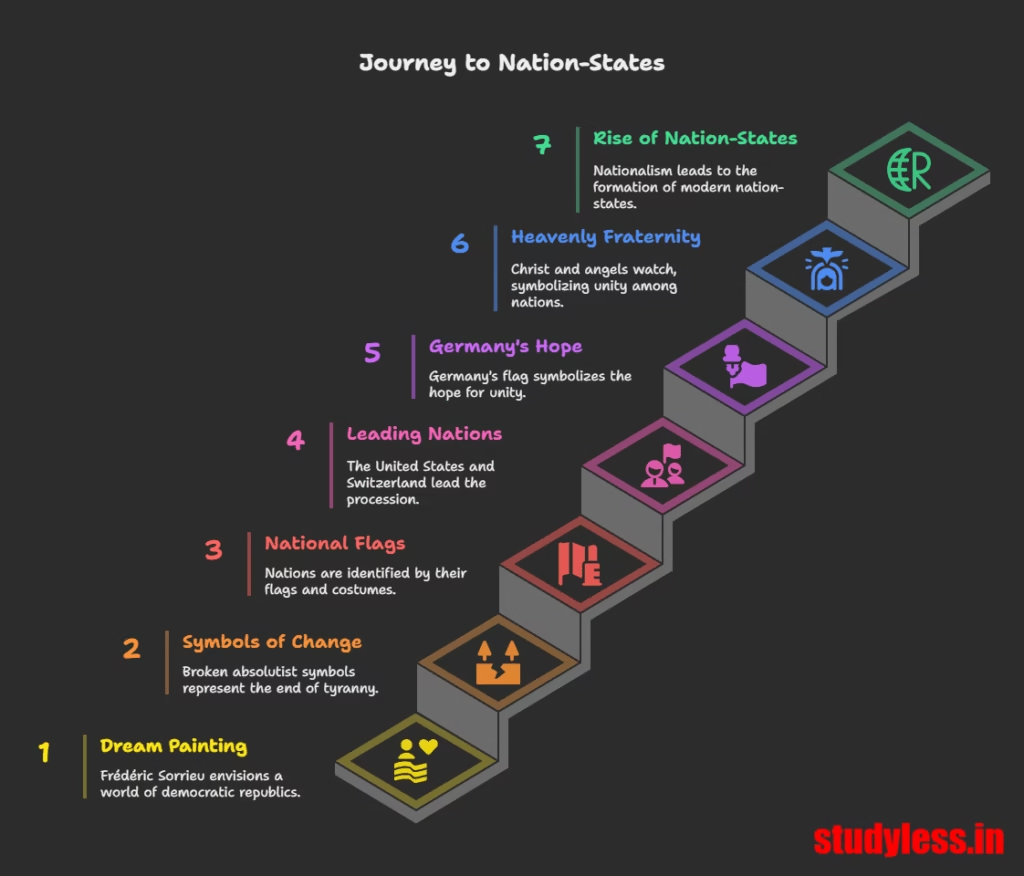
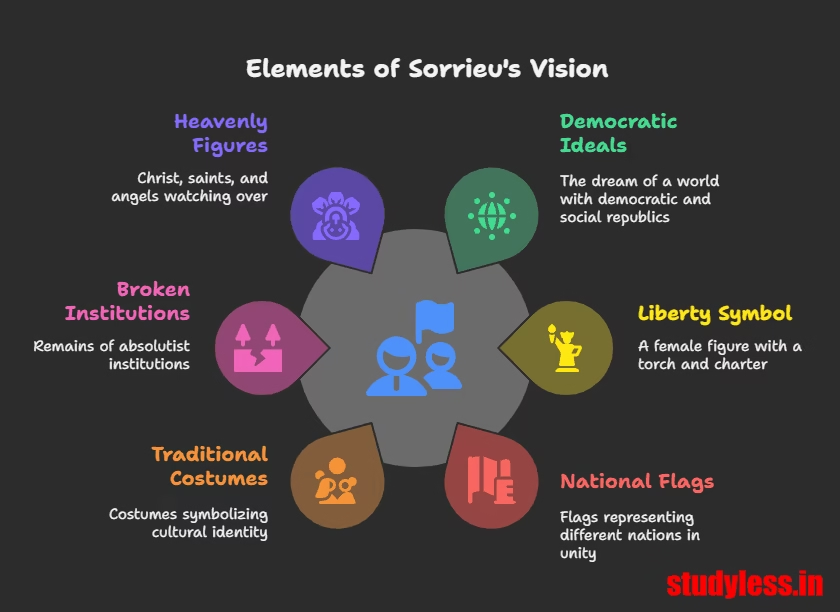
What This Chapter Explores
- How nationalism in 19th-century Europe led to:
- Fall of multi-national dynastic empires
- Rise of modern nation-states
- A nation-state: A region where citizens share:
- Common identity
- Shared history or descent
- This commonness was not natural, but built through:
- Struggles
- Leadership
- People’s movements
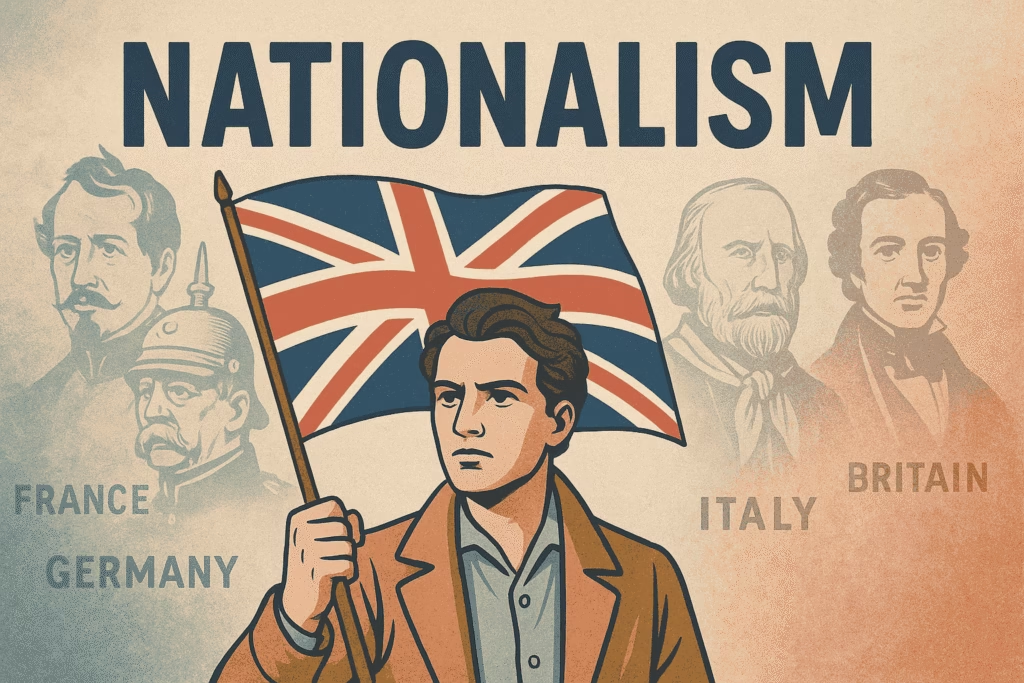
The French Revolution and Nationalism
🗽 Birth of Nationalism – 1789
- The French Revolution (1789) was the first clear expression of nationalism.
- France, then ruled by an absolute monarch, transferred sovereignty to citizens.
- It declared: “The people will form the nation and shape its destiny.”
🧩 Steps to Build National Identity
The French revolutionaries took major steps to instill a collective identity:
- Introduced concepts like:
- La patrie (the fatherland)
- Le citoyen (the citizen)
- Replaced royal flag with the tricolour.
- Renamed the Estates General as the National Assembly.
- Composed new hymns, took oaths, and honoured martyrs in the nation’s name.
- Centralised administration created:
- Uniform laws
- Standard weights and measures_
- Abolition of internal tariffs
- Promoted Parisian French as the common national language.
- Mission declared: Liberate Europe from despotism and help create nation-states.
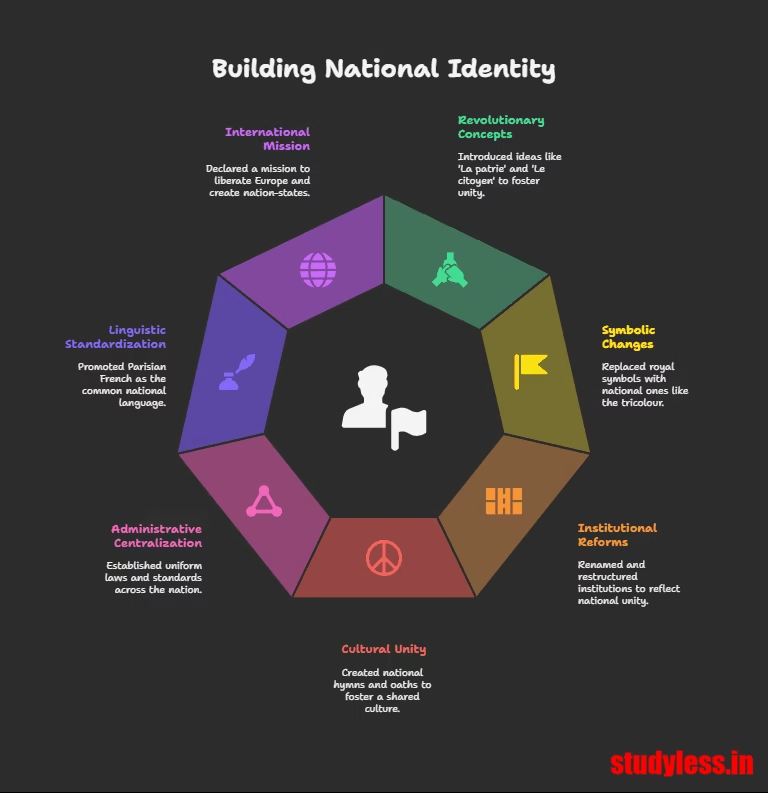
🌍 Spread of Nationalism Across Europe
📚 Jacobin Clubs and Youth Movements
- Educated middle classes and students across Europe created Jacobin clubs.
- Helped prepare the ground for French revolutionary armies.
- French armies spread nationalist ideas into:
- Holland, Belgium, Switzerland, Italy.
👑 Napoleon and Nationalism
⚖️ Napoleon’s Role: A Mix of Reform and Control
- Though he restored monarchy, Napoleon:
- Carried revolutionary ideals in administration.
- Introduced the Civil Code of 1804 (Napoleonic Code):
- Abolished privileges by birth
- Ensured equality before the law
- Secured right to property
🛠️ Reforms in Conquered Lands
- Applied reforms to:
- Dutch Republic, Switzerland, Italy, Germany
- Changes included:
- Simplified administrative divisions
- Abolished feudalism
- Freed peasants from serfdom
- Ended guild restrictions in towns
- Improved transport & communication
- Standardised laws, currency, weights and measures
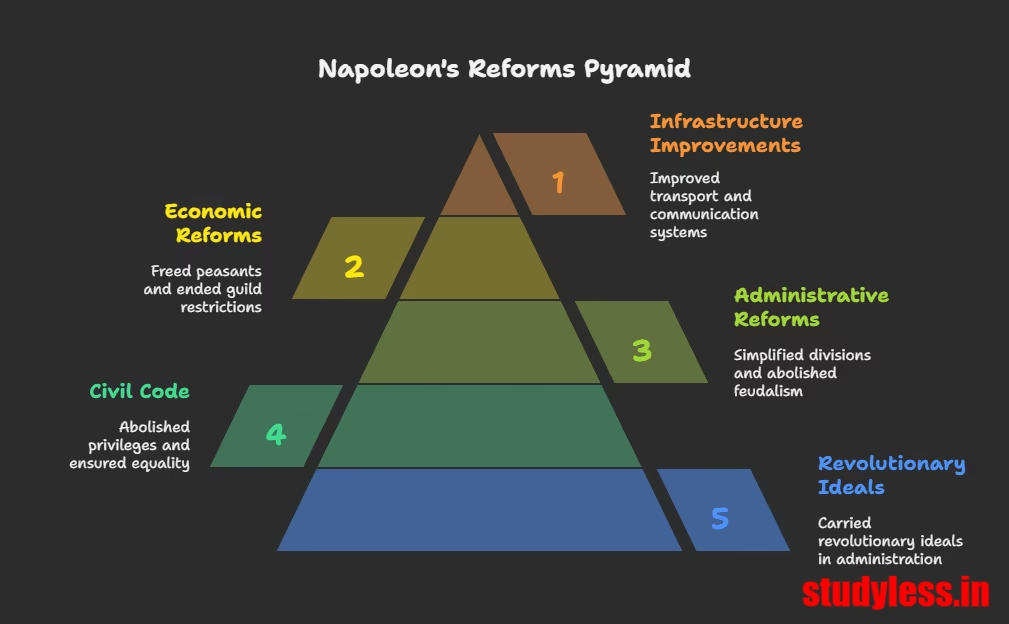
⚠️ Mixed Reactions to French Rule
- Initial welcome in cities like:
- Brussels, Milan, Warsaw, Mainz
- Enthusiasm faded due to:
- Increased taxation
- Censorship
- Forced army conscription
- People realised that administrative reform came without political freedom.
The Making of Nationalism in Europe
🗺️ Europe Before Nation-States
🧭 Fragmented Political Map (Mid-1700s)
- No modern nation-states like Germany, Italy, or Switzerland.
- The region was divided into kingdoms, duchies, and cantons.
- Each territory was ruled autonomously by different monarchs.
🧬 Diverse Peoples, No Common Identity
- Eastern and Central Europe were ruled by autocratic monarchies.
- Populations were:
- Ethnically diverse
- Spoke different languages
- Practised varied cultures
- People did not see themselves as one nation.
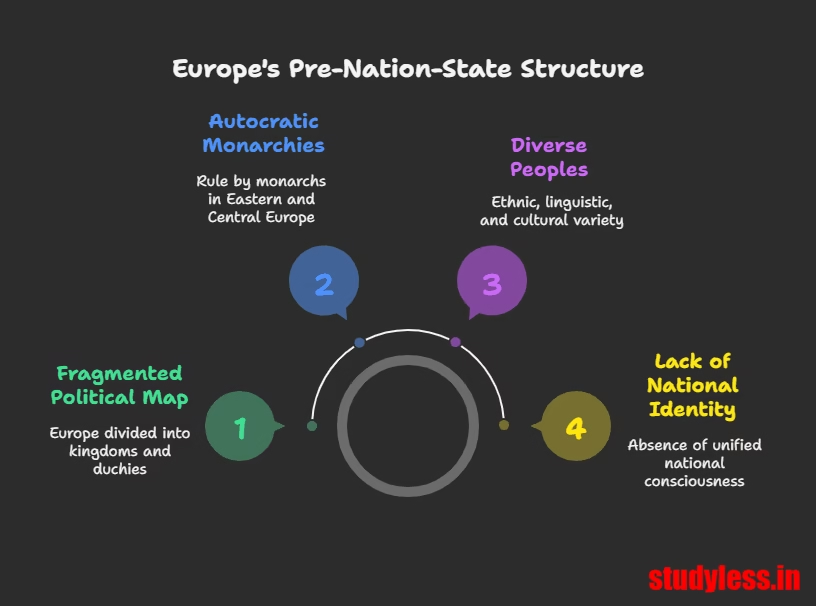
🏰 The Habsburg Empire: A Patchwork Puzzle
- Ruled over Austria-Hungary, it was multinational and multi-lingual.
📌 Key Regions:
| Region | Dominant Group or Language |
|---|---|
| Tyrol, Austria, Sudetenland (Alpine regions) | German-speaking aristocracy |
| Bohemia | German-speaking aristocracy |
| Lombardy & Venetia | Italian-speaking |
| Hungary | Magyar and other dialects |
| Galicia | Polish-speaking aristocracy |
👨🌾 Other Groups:
- Bohemians, Slovaks (North)
- Slovenes (Carniola)
- Croats (South)
- Roumans (Transylvania, East)
🧷 Only Unifying Factor:
- Common allegiance to the Emperor

The Aristocracy and the New Middle Class
👑 The Landed Aristocracy: Power & Privilege
- Dominated social and political life across Europe.
- Landed aristocrats owned estates in the countryside and townhouses in cities.
- Lived a common lifestyle:
- Spoke French in diplomacy and society.
- Intermarried across regions and countries.
- Despite their power, they were numerically few.
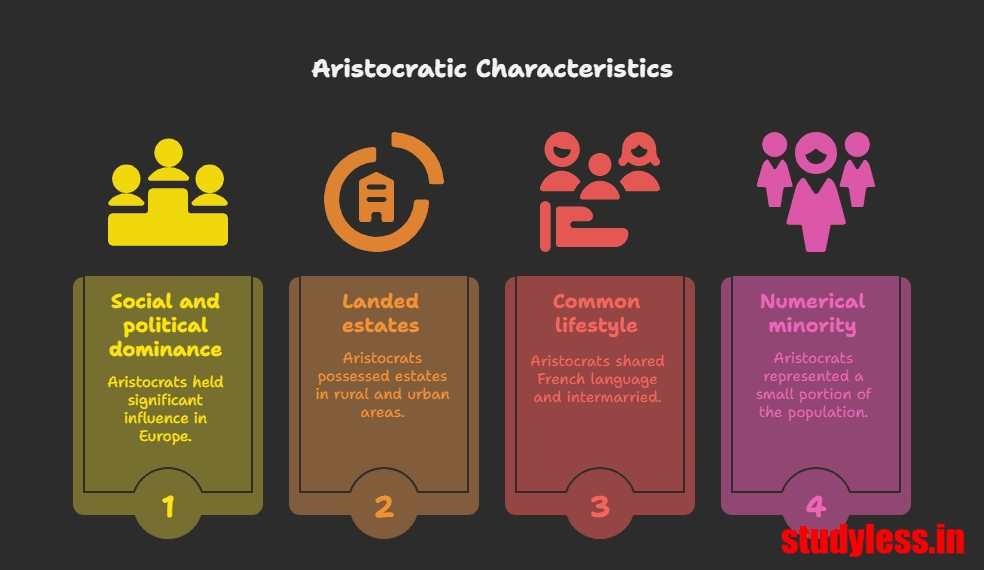
🚜 The Majority: Peasantry
- Made up the largest portion of the population.
- Landholding patterns:
- Western Europe: Land farmed by small owners and tenants.
- Eastern & Central Europe: Large estates worked by serfs (unfree peasants).
🏭 Rise of the New Social Classes
📈 Impact of Industrialisation
- Started in England (late 1700s).
- Spread to France and German states in the 1800s.
- Led to growth of:
- Towns
- Trade
- Commercial classes (based on market production)
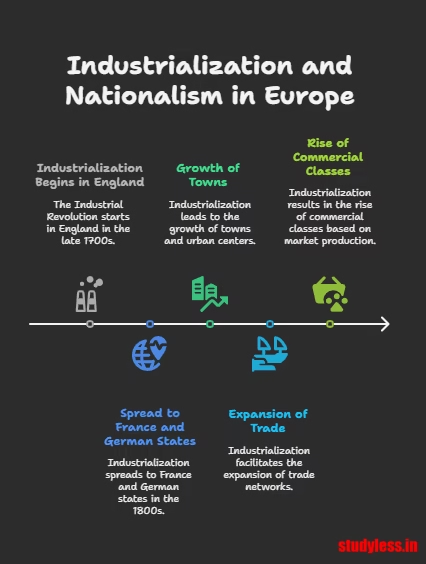
🧑🏭 New Classes Emerged:
- Working class
- Middle class: Industrialists, businessmen, professionals
🧠 The Middle Class & Nationalism
- Mostly educated, liberal and urban.
- Supported abolition of aristocratic privileges.
- Played a key role in spreading the idea of national unity.
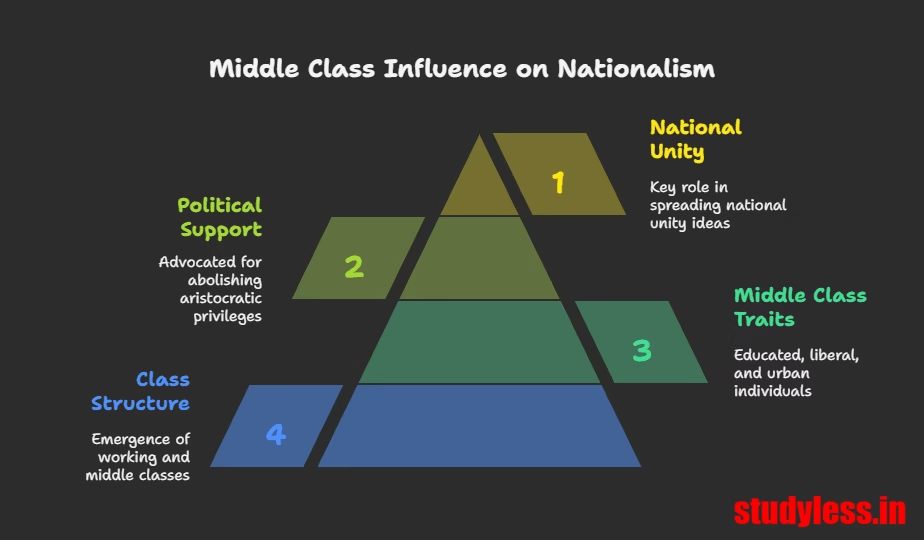
What did Liberal Nationalism Stand for?
🗽 Meaning of Liberalism
- Derived from Latin liber meaning free.
- Supported by the middle class in early 19th-century Europe.
- Meant:
- Individual freedom
- Equality before the law
- Government by consent
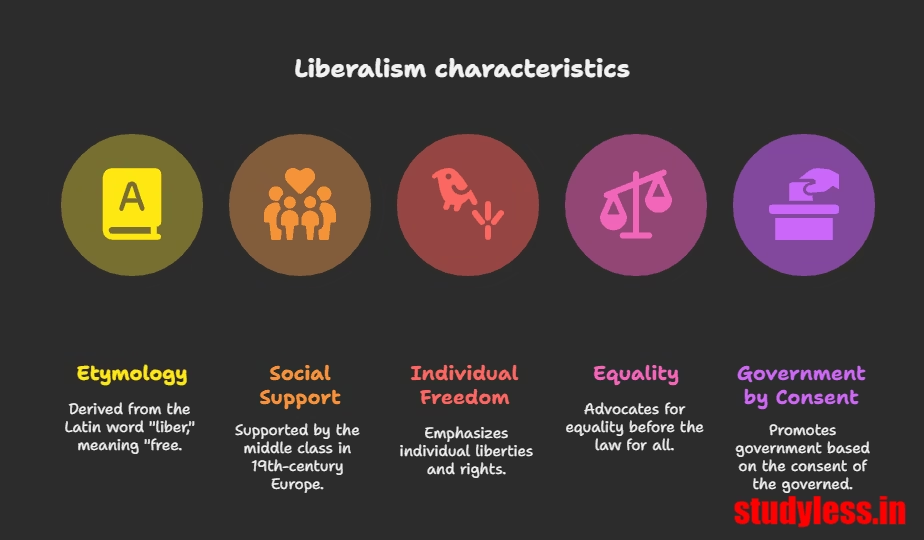
🏛️ Political Ideals of Liberalism
- End of autocracy and clerical privileges
- Rule by constitution and parliament
- Private property seen as sacred
- Suffrage (right to vote) not universal:
- Only property-owning men could vote.
- Women and non-propertied men were excluded.
- Jacobins briefly gave all adult males the vote, later reversed by Napoleon.
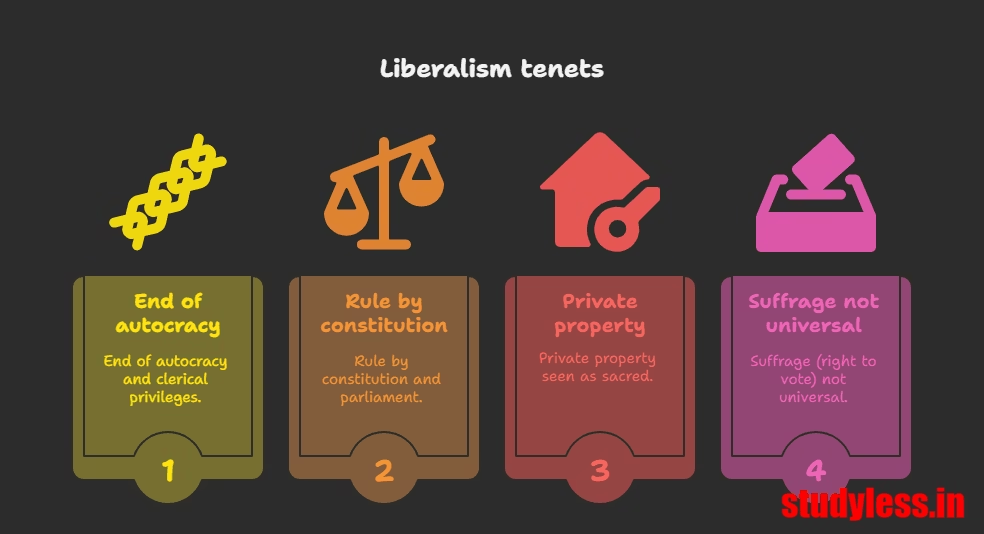
💼 Economic Liberalism
- Called for:
- Free markets
- No state restrictions on goods and capital
- Middle class demanded:
- Unification of economic territories
- Removal of customs duties, currency chaos, and inconsistent weights/measures
🚂 Example: German Confederation
- 39 small states, each with:
- Own currency
- Own weights and measures
- Multiple customs barriers
- A merchant from Hamburg to Nuremberg paid ~5% duty at 11 stops!
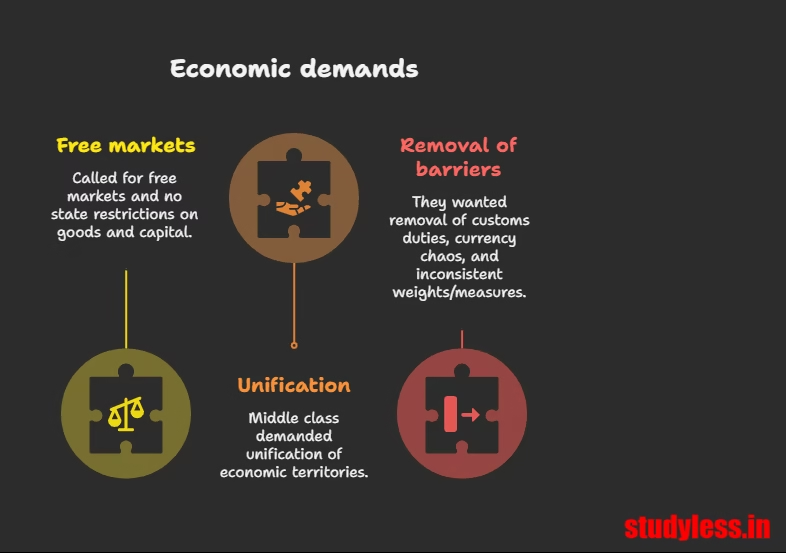
🔗 Formation of Zollverein (1834)
- A customs union initiated by Prussia.
- Goals:
- Abolish tariffs
- Reduce currencies from 30+ to 2
- Built railways to increase mobility.
- Sparked economic nationalism, which strengthened nationalist sentiments
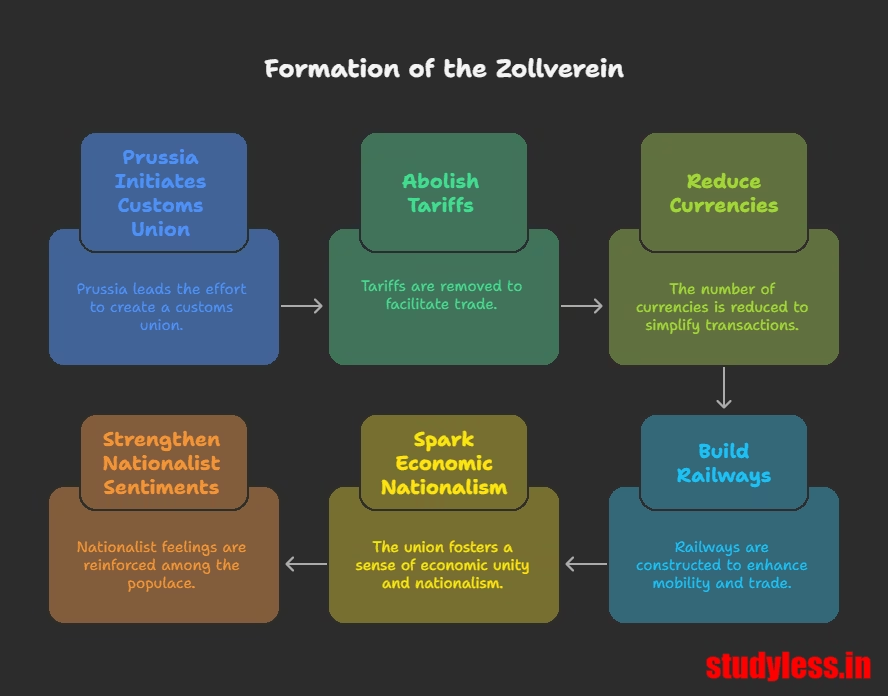
A New Conservatism after 1815
⚔️ Background: Post-Napoleon Europe
- After Napoleon’s defeat in 1815, European governments feared revolution.
- They adopted conservatism, an ideology focused on preserving traditional institutions:
- Monarchy
- Church
- Social hierarchies
- Private property
- Family system

🛡️ Conservative Beliefs
- Did not want to go back to pre-1789 society.
- Believed in modernization to strengthen monarchy:
- Efficient bureaucracy
- Modern army
- Strong economy
- Abolition of feudalism and serfdom
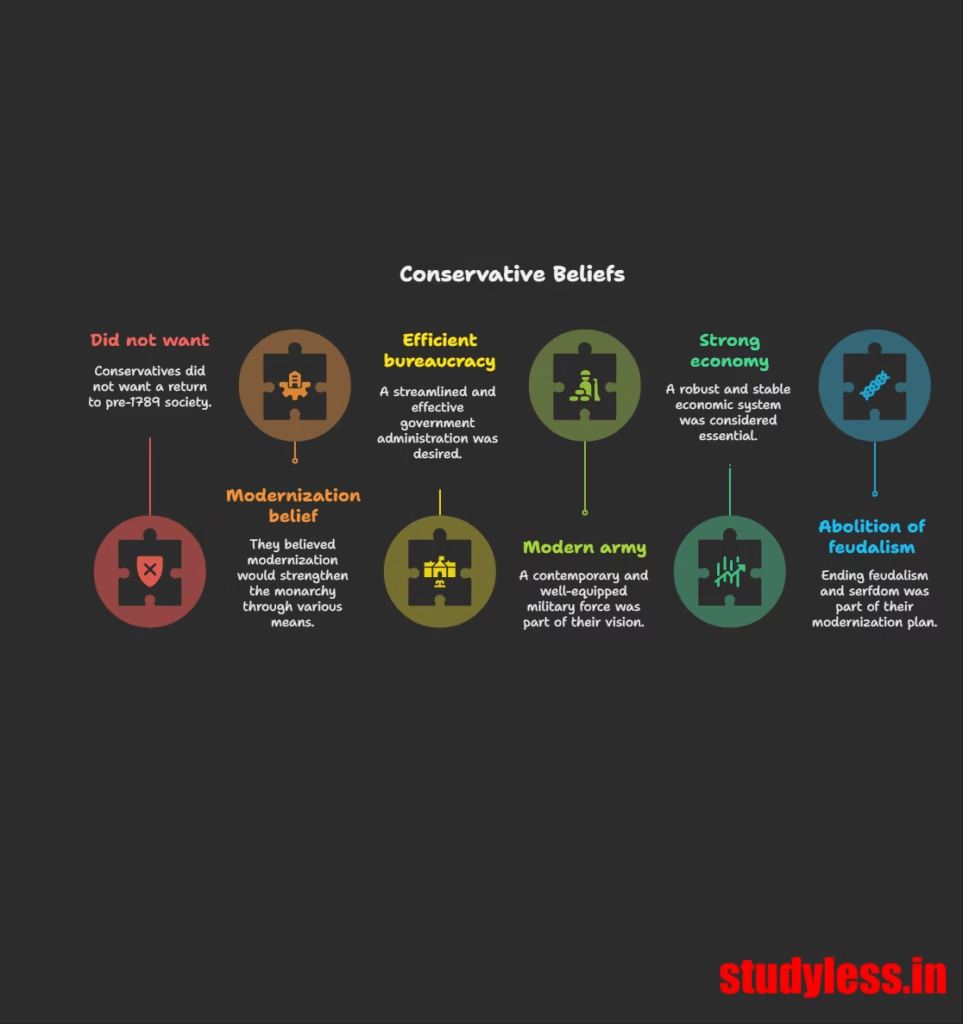
🤝 The Congress of Vienna (1815)
- Held in Vienna, led by Austrian Chancellor Metternich.
- Attended by Britain, Russia, Prussia, Austria.
- Aimed to undo Napoleonic changes and restore old order.
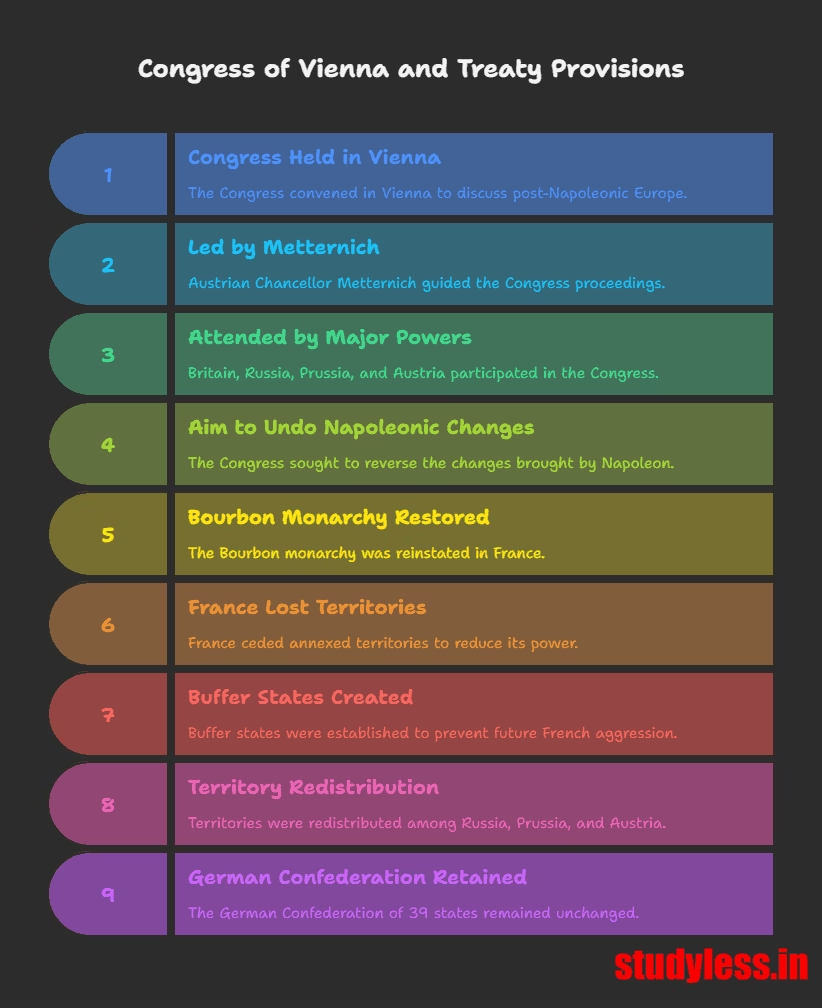
✍️ Key Provisions of the Treaty of Vienna:
| Action | Purpose |
|---|---|
| Bourbon monarchy restored | Return to pre-revolution France |
| France lost annexed territories | Reduce future French aggression |
| Buffer states created on the boundaries of France | Netherlands (north), Genoa to Piedmont (south) |
| Territory redistribution | Russia → part of Poland Prussia → part of Saxony Austria → control of northern Italy |
| German Confederation (39 states) | Retained (no changes) |
🔒 Features of Conservative Regimes
- Autocratic rule: No checks on monarchs.
- No tolerance for criticism or dissent.
- Strict censorship:
- Controlled press, books, plays, songs.
- Suppressed ideas of liberty, equality, and freedom.
📢 Resistance from Liberals
- Inspired by the French Revolution.
- Liberal-nationalists demanded:
- Freedom of the press
- End to censorship
- Political participation and constitutional government
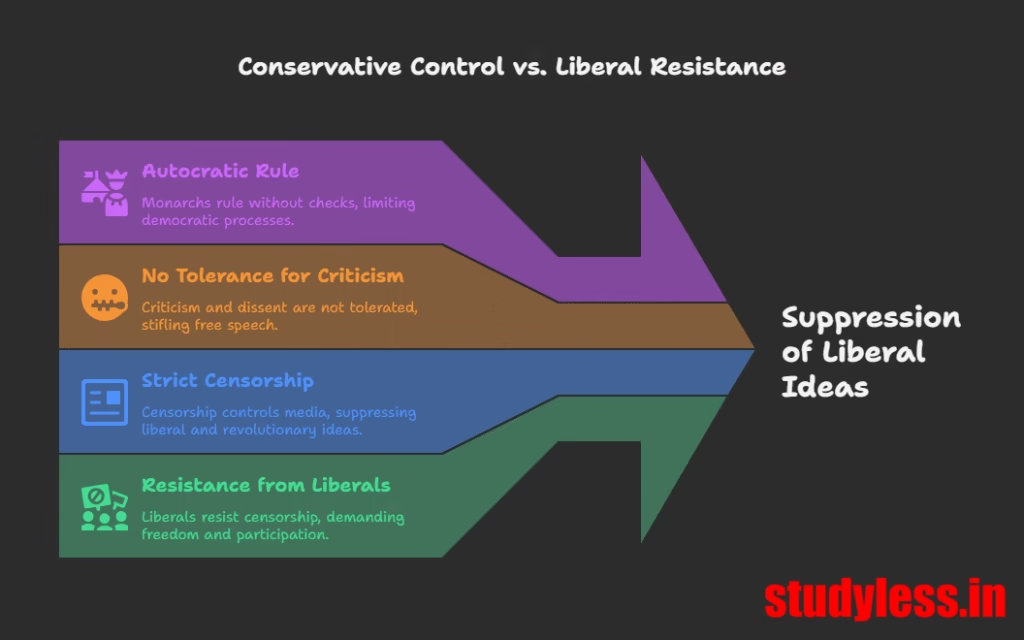
The Revolutionaries (After 1815)
🔥 Why Revolutionaries Emerged
- After the Congress of Vienna (1815), conservative monarchies returned to power.
- Repression of liberal ideas like liberty, equality, and nationalism began.
- Liberal-nationalists went underground to continue their work in secret.
- Secret societies were formed to:
- Train revolutionaries.
- Spread the message of freedom, liberty, and nation-states.
🕵️ Secret Societies and Their Goals
- Goal: End monarchy, promote democracy, and unify fragmented regions into nation-states.
- Belief: Freedom and nationalism go hand in hand.
- Spread across Germany, France, Switzerland, Poland, and Italy.
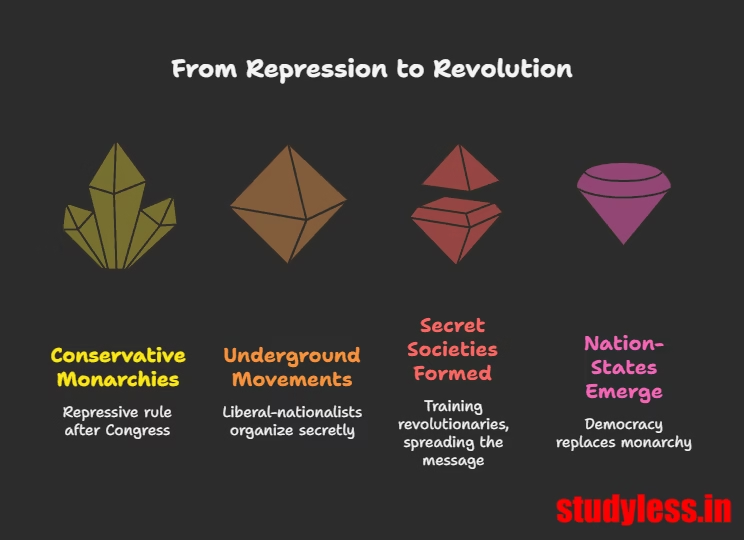
Giuseppe Mazzini – The Torchbearer
| Feature | Details |
|---|---|
| Born | 1805, Genoa, Italy |
| Joined | Secret society Carbonari |
| Exiled at 24 | For a failed revolution in Liguria (1831) |
| Founded | Young Italy (Marseilles) & Young Europe (Berne) |
| Beliefs | – Nations = Natural units of humanity – Italy must become one unified republic |
| Influence | Inspired youth across Europe to oppose monarchy and fight for democracy |
| Feared by | Conservatives like Metternich, who called him “most dangerous enemy of our social order” |
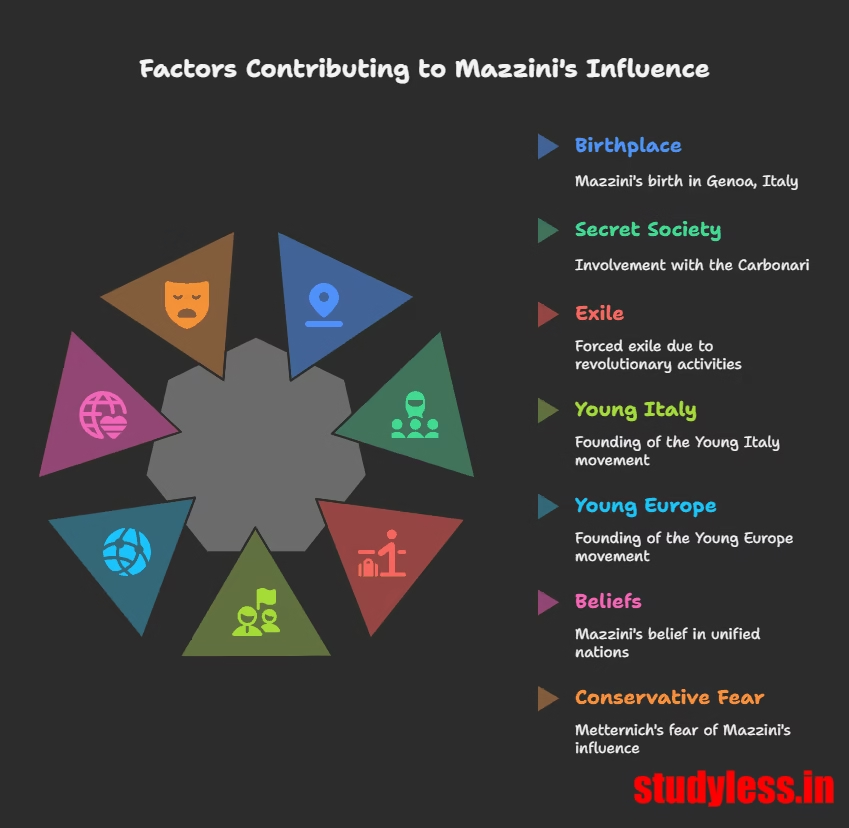
The Age of Revolutions: 1830-1848
As conservative regimes tried to stay in control, liberalism and nationalism started fueling revolutions across Europe — especially in:
- Italian & German states
- Ottoman Empire provinces
- Ireland & Poland
These uprisings were mostly led by the educated middle-class elite, including:
- Professors
- Teachers
- Clerks
- Businessmen
July Revolution of 1830 – France
- Bourbon kings (restored after 1815) were overthrown
- A constitutional monarchy was formed under Louis Philippe
- Famous quote by Metternich:
“When France sneezes, the rest of Europe catches cold.”
📌 Impact:
- Sparked a revolt in Brussels
- Led to Belgium’s independence from the United Kingdom of the Netherlands
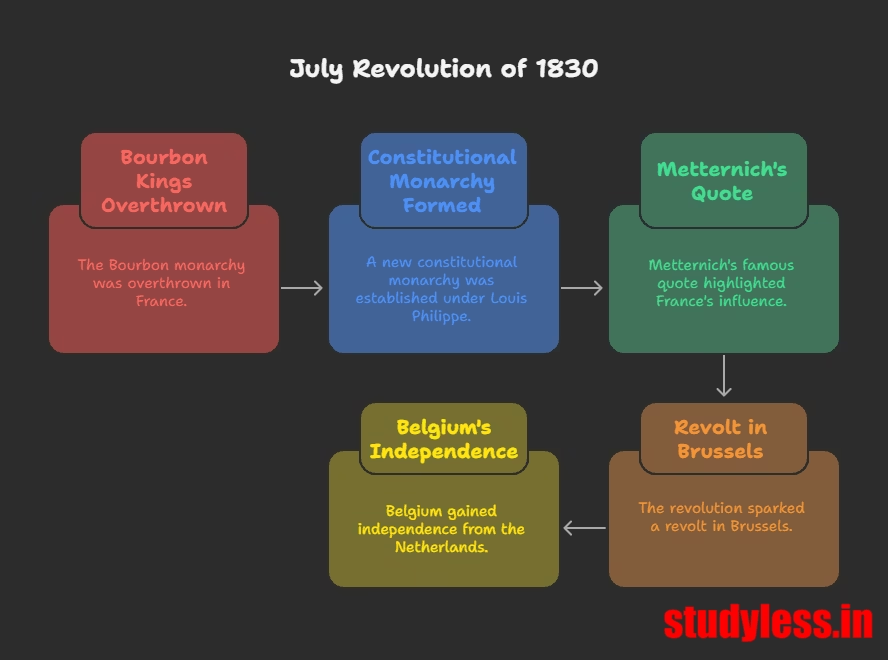
Greek War of Independence (1821–1832)
- Greece was part of the Ottoman Empire since the 15th century
- Inspired by revolutionary nationalism
- Supported by:
- Greeks in exile
- Western European artists & poets lauded Greece as the “cradle of European civilisation” (mobilized opinion).
🖋️ Lord Byron (English poet):
- Funded the Greek cause
- Died of fever in 1824 during the war
🕊️ Result:
- Treaty of Constantinople (1832) officially recognised Greece as an independent nation

The Romantic Imagination and National Feeling
Romanticism & Nationalism = Culture as the Soul of the Nation
What Is Romanticism?
Romanticism = A cultural movement that inspired nationalism by glorifying emotions, folklore, and tradition, not just logic and science.
- Opposed Enlightenment’s obsession with reason & rationality
- Celebrated intuition, mysticism, and the spirit of the people
- Artists, poets, and musicians shaped identity by evoking pride in shared culture
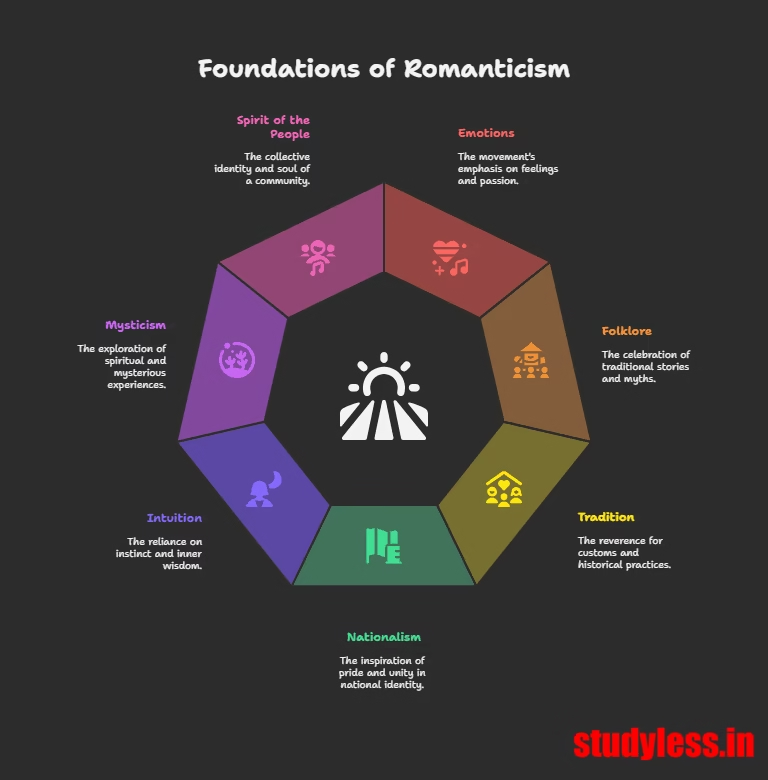
German Roots: Das Volk & Volksgeist
“The soul of a nation lies in its people, not its rulers.”
- 💡 Johann Gottfried Herder:
- Real German culture lives among the common people (das volk)
- Folk songs, dances, and poetry = true national spirit (volksgeist)
- Nationalism spread through:
- Collection of folk tales
- Promotion of vernacular language
- Revival of oral traditions
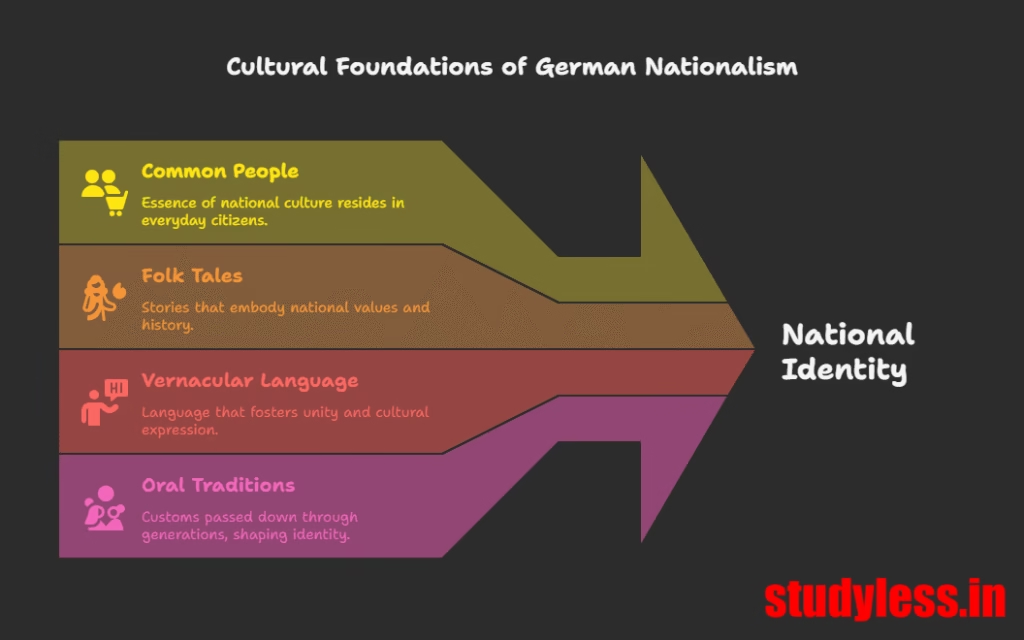
Poland: Nation Without a State
Culture became resistance when borders disappeared.
- Poland partitioned by Russia, Prussia, Austria
- 🇵🇱 No independence, but national spirit lived on through:
- 🎶 Karol Kurpinski’s music: Turned folk dances (e.g., mazurka, polonaise) into symbols of nationalism
- 📚 Polish language: Suppressed by Russia but preserved in:
- Church services
- Religious teachings
- Underground education
- 🛐 Clergy became cultural warriors:
- Used Polish to preach despite bans
- Many jailed or sent to Siberia
- 🗣️ Language = Weapon of resistance
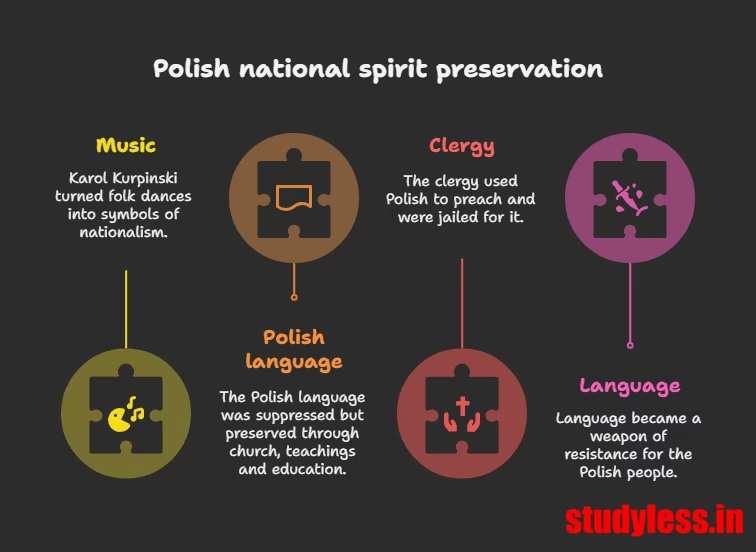
Hunger, Hardship and Popular Revolt
“When hunger walks the streets, revolution is not far behind.”
Economic Crisis in Europe (1830s–1840s)
- Population Explosion: Rapid growth led to job scarcity
- Rural to Urban Migration: Cities grew crowded with slum dwellers
- Industrial Competition:
- England’s machine-made goods outcompeted home-based producers on the continent
- Worst hit: textile workers in partly mechanised regions
- Agrarian Distress:
- Feudal dues still burdened peasants in aristocratic regions
- Bad harvests & food price rise = widespread pauperism
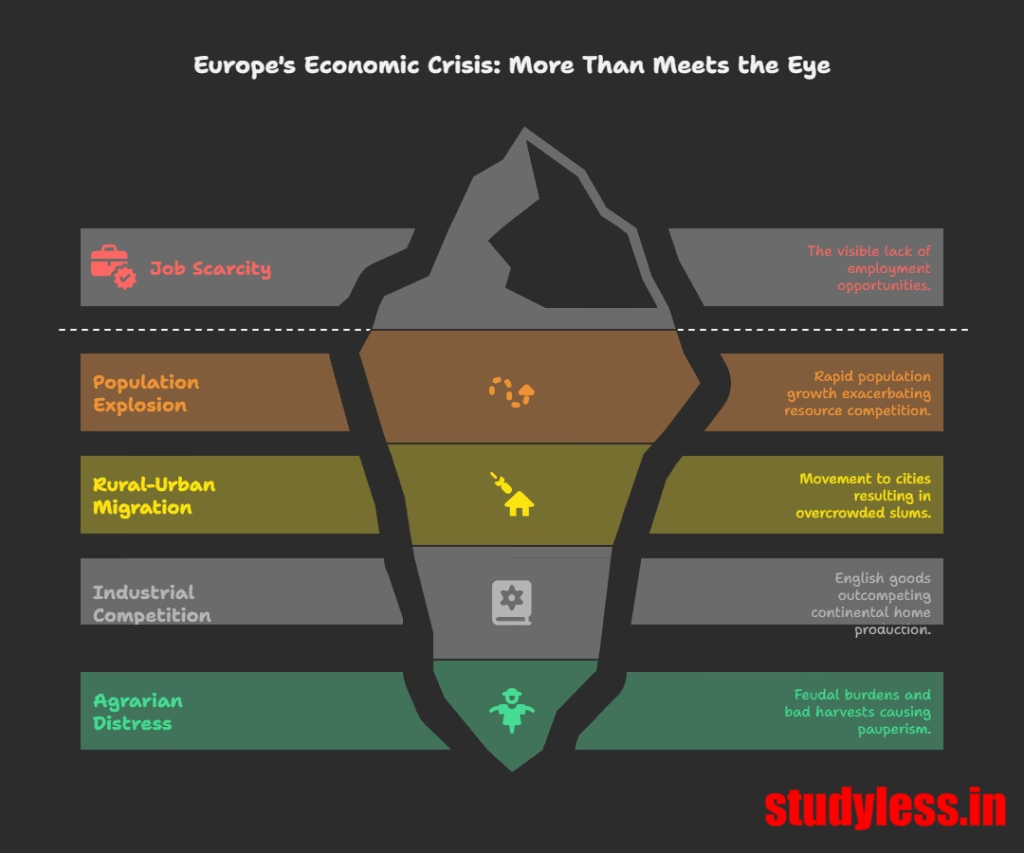
1848: Year of Revolutions
France Uprising (February 1848)
- Triggered by food shortage and unemployment
- Barricades in Paris → King Louis Philippe fled
- Outcome:
- A new Republic declared
- Universal male suffrage (21+)
- Right to work granted
- National workshops set up to provide employment
Silesian Weavers’ Revolt (1845)
A powerful example of industrial exploitation → mass revolt
- Silesia (Prussia): Cotton weaving = main livelihood
- Contractors reduced payment rates, exploiting job scarcity
- Workers demanded higher wages → met with threats
- Workers’ reaction:
- Stormed contractor’s mansion → destroyed property
- Broke into storehouse, tore cloth into shreds
- Army called in → 11 weavers shot dead
- Reported by journalist Wilhelm Wolff
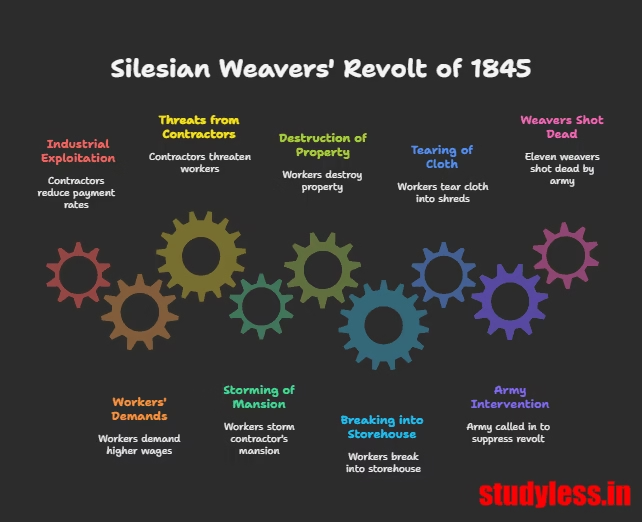
1848: The Revolution of the Liberals
Liberals = Educated Middle Class
Goals of the Liberal Middle Class
- Demand for:
- Constitutionalism
- National unification
- Freedom of press & association
- Key regions involved:
- Germany
- Italy
- Poland
- Austro-Hungarian Empire
The Frankfurt Parliament (Germany)
The first attempt to unify Germany under constitutional monarchy
- 18 May 1848: 831 elected reps from across German states gathered at Church of St Paul, Frankfurt.
- A constitution was drafted for a unified Germany led by a monarch controlled by parliament.
- Crown offered to King Friedrich Wilhelm IV (Prussia) – he rejected it.
- Why it failed?
- Rejection by aristocracy and military
- Middle-class ignored working-class demands
- Popular support declined
- Assembly disbanded by force
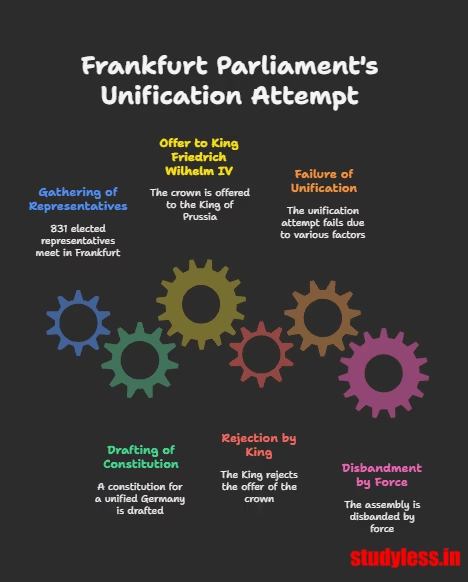
👩🦰 Women in the Revolution
- Women:
- Formed political associations
- Founded newspapers
- Participated in demonstrations
- However:
- Denied voting rights
- Allowed only as observers in Frankfurt Parliament
🔄 Aftermath & Impact
- Conservative forces crushed revolts, but…
- Old order couldn’t return.
- Monarchs learned: Permanent repression would fail.
- Post-1848 reforms:
- Serfdom abolished in Russia and Habsburg Empire
- Hungary granted autonomy in 1867
The Making of Germany
Germany: Nation-Building Through the Army
🧨 From 1848 Liberalism to Conservative Nationalism
- 1848: German middle-class liberals attempted unification via a parliamentary system.
- Outcome? Crushed by:
- The monarchy
- The military
- Prussian aristocrats (Junkers= Large land owners)
🧠 Shift in Nationalism
After 1848, nationalism = state power, not democracy.
- Conservatives now used nationalism to:
- Strengthen monarchy
- Expand influence over Europe
🧱 Role of Prussia and Otto von Bismarck
- Prussia assumed leadership of German unification.
- Otto von Bismarck (Chief Minister of Prussia):
- Led unification via “Blood and Iron”
- Relied on Prussian army and bureaucracy
⚔️ Wars That United Germany
| War | Year | Opponent | Result |
|---|---|---|---|
| Danish War | 1864 | Denmark | Prussia wins |
| Austro-Prussian War | 1866 | Austria | Prussia wins |
| Franco-Prussian War | 1870 | France | Prussia wins → Final unification step |
👑 1871: Birth of the German Empire
- 18 Jan 1871: In the Hall of Mirrors, Palace of Versailles:
- King William I of Prussia declared Kaiser (Emperor) of unified Germany.
- Attendees: German princes, Prussian army reps, Bismarck.
⚙️ Post-Unification Reforms
- Emphasis on:
- Modern currency
- Banking systems
- Unified legal & judicial systems
- Prussian systems became the model for all of Germany.
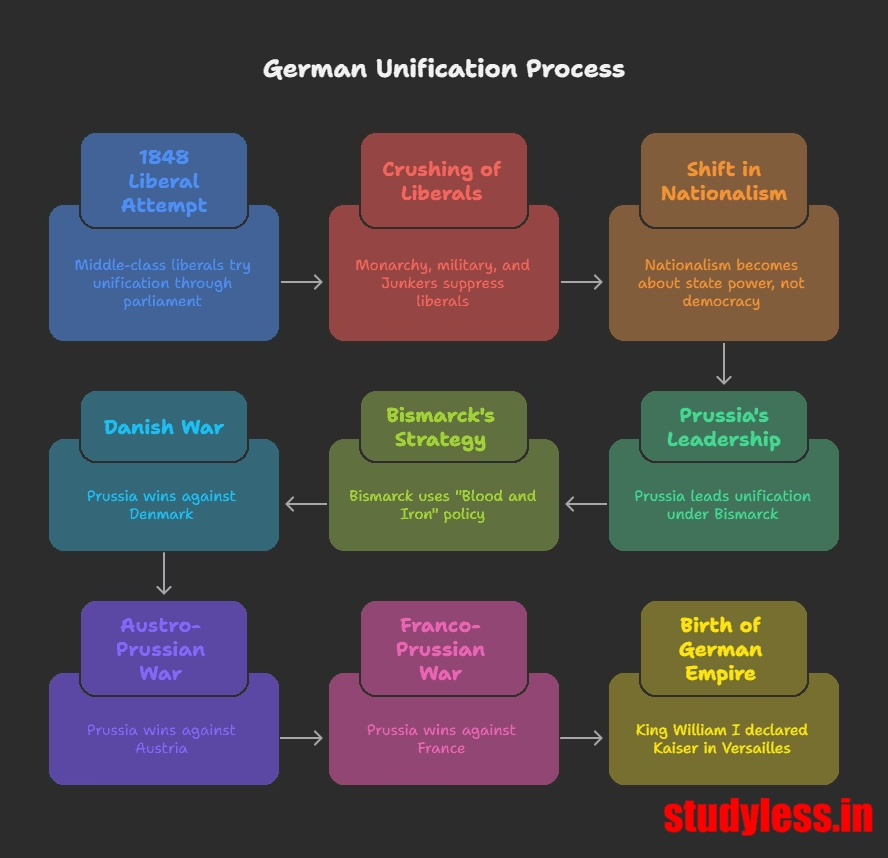
The Unification Of Italy – From Fragmented States to a Unified Nation
🧩 Political Puzzle Before Unification
- Italy in mid-19th century = 7 separate states
- North → Controlled by Austrian Habsburgs
- Centre → Ruled by the Pope
- South → Under Bourbon kings of Spain
- Only Sardinia-Piedmont ruled by an Italian princely house
- Language barrier: No standard Italian, many local dialects
🧠 Mazzini & Young Italy Movement
- Giuseppe Mazzini: Revolutionary thinker of the 1830s
- Formed secret society: Young Italy
- Vision: Unified Republican Italy
- 1831 & 1848 revolts failed → task shifted to Sardinia-Piedmont under King Victor Emmanuel II
🎩 Cavour – The Diplomatic Brain
- Count Camillo di Cavour: Chief Minister of Sardinia-Piedmont
- A conservative, not a revolutionary
- Spoke French better than Italian
- Crafted a smart alliance with France → Defeated Austria in 1859
🗡️ Garibaldi & the Redshirts
- Giuseppe Garibaldi: Charismatic leader of volunteer army (Redshirts)
- 1860: Marched into South Italy & Kingdom of Two Sicilies
- Supported by peasants → drove out Spanish rulers
👑 1861: A Nation is Born
- Victor Emmanuel II proclaimed King of Unified Italy
- BUT…
- High illiteracy meant most peasants didn’t understand nationalism
- Many thought “Italia” was “La Talia” – the king’s wife!
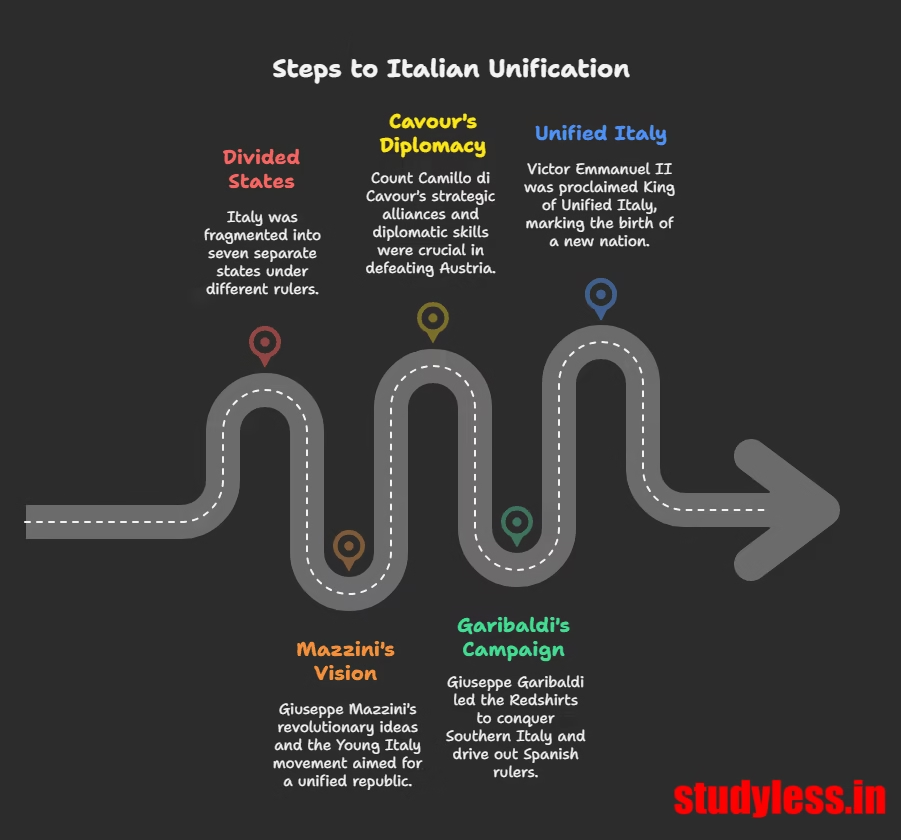
The Strange Case of Britain
(Nation-Building Without Revolution)
🏛️ Not a Revolution, But a Gradual Process
- Unlike France, Britain’s nation-state wasn’t born out of sudden revolutions.
- It was shaped over centuries through parliamentary power and English dominance.
🧬 Before Nationhood: A Patchwork of Identities
- The British Isles were once home to ethnic identities:
- English, Welsh, Scots, Irish
- Each had distinct languages, cultures, and political systems.
🔗 The Act of Union (1707)
- England + Scotland = United Kingdom of Great Britain
- England used its wealth and power to:
- Dominate the Scottish parliament
- Suppress Scottish culture (e.g. Gaelic language, national dress)
- Repress Highlanders whenever they resisted English control
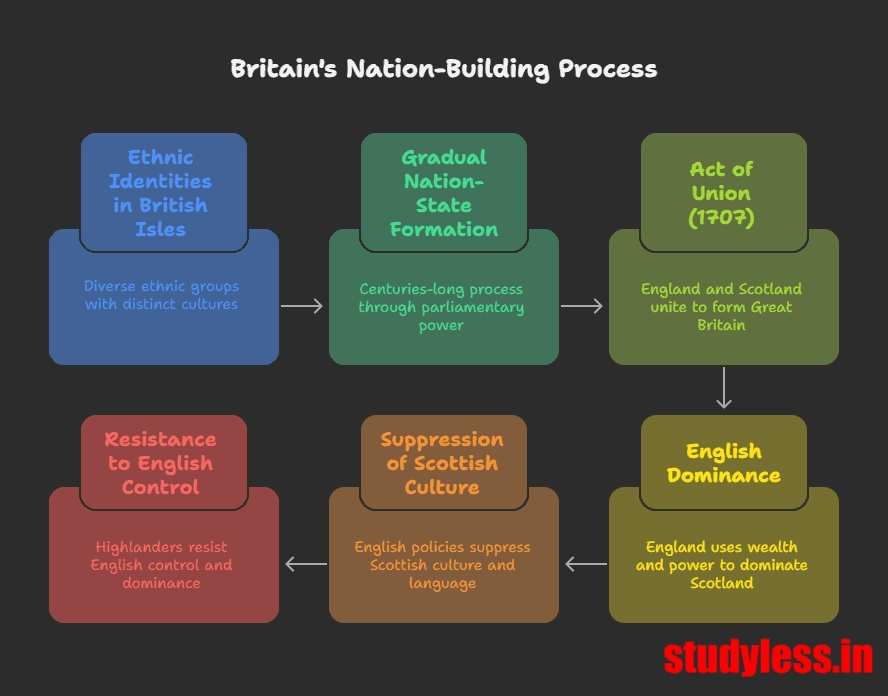
Ireland: A Tale of Suppression
- Ireland was divided:
- Protestants (favored by England)
- Catholics (majority, but oppressed)
- Catholic revolts were crushed:
- 1798: Rebellion by Wolfe Tone and the United Irishmen failed.
- 1801: Ireland forcibly joined the United Kingdom.
🏴☠️ Making of the “British Nation”
- The dominant English culture became the face of the union:
- 🏁 Union Jack (British flag)
- 🎵 God Save the King (national anthem)
- 🗣️ English language
- Other cultures survived as subordinates, not equals.
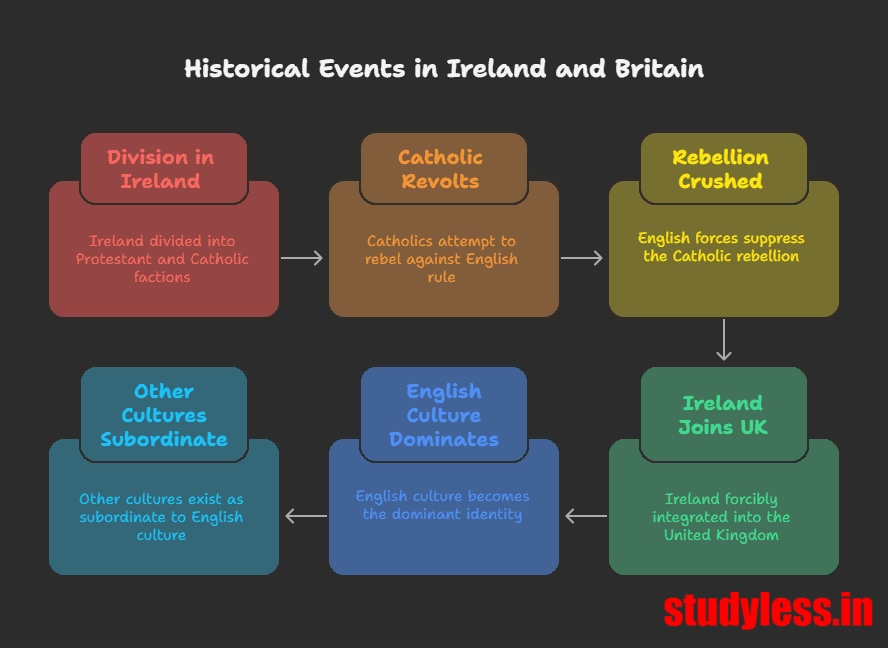
Visualising the Nation
Giving a Face to the Nation
🖼️ Problem Faced by Artists
- Easy to depict a ruler with a portrait or statue.
- But how to show a nation, which is an abstract idea?
👩 Personification of Nation
- Artists in the 18th and 19th centuries began to personify nations.
- Nations were shown as female figures.
- These figures were not real women, but allegories (symbols with meaning).
📌 Allegory = Giving abstract ideas a human form to make them relatable.
The French Example: Marianne
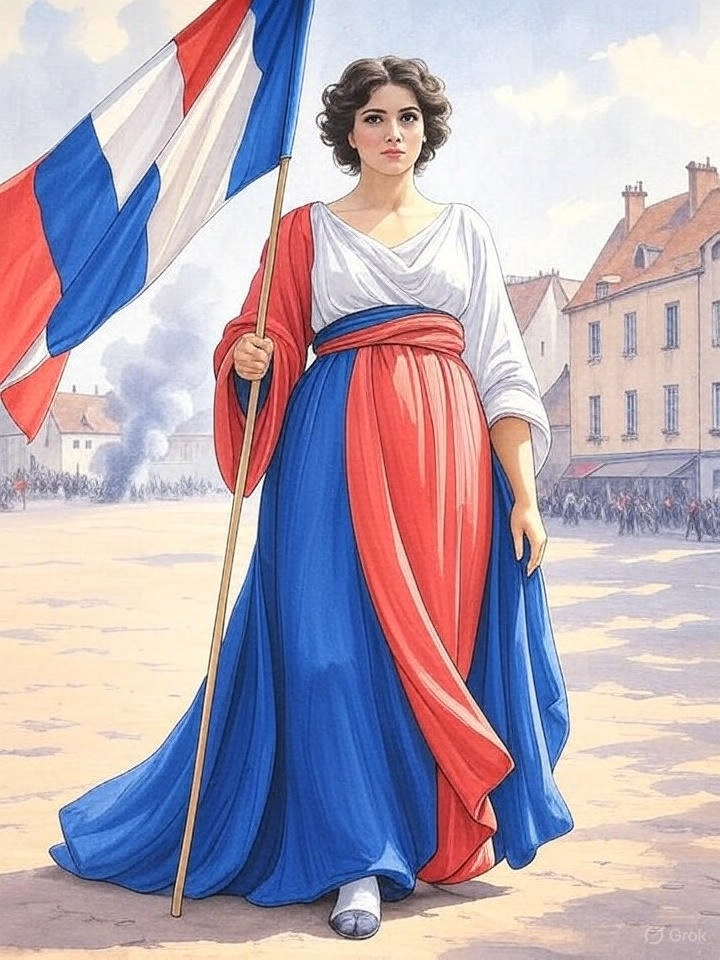
- During the French Revolution, female allegories stood for:
- Liberty 🕊️ – shown with a red cap or broken chain.
- Justice ⚖️ – a blindfolded woman holding weighing scales.
- Republic 👥 – representing the people’s power.
- The female figure of France was named Marianne:
- Symbolised a people’s nation.
- Wore symbols of Liberty & Republic:
- Red cap, tricolour, cockade.
- Statues of Marianne were placed in public squares.
- Her image appeared on coins and stamps.
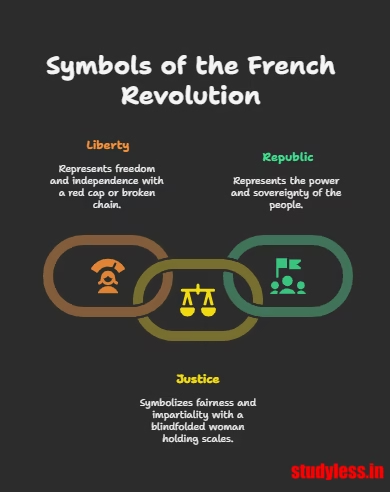
The German Example: Germania

- Germania personified the German nation.
- Wore a crown of oak leaves 🌿 — the oak symbolised heroism in Germany.
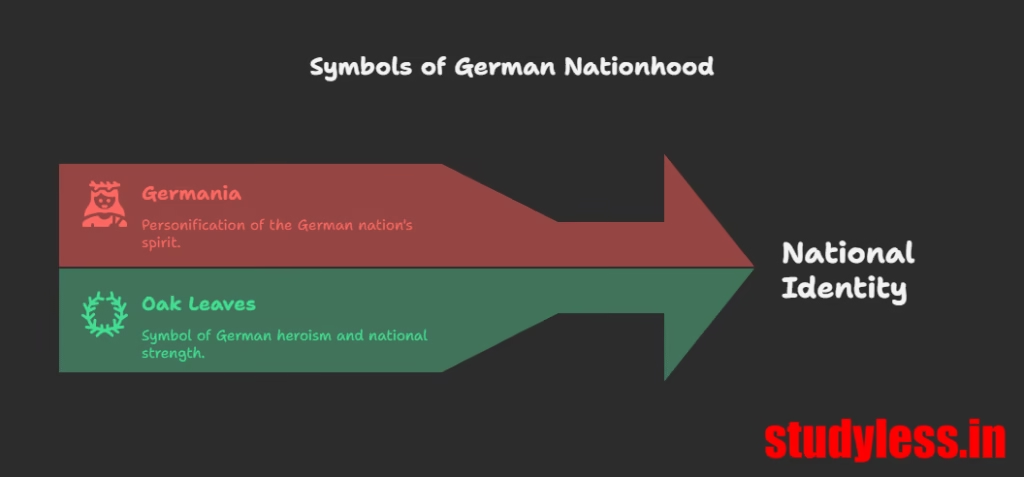
Quick Recap
- Nations were given human faces through female allegories.
- These helped people emotionally connect with the nation.
- The figures became tools to spread national unity and patriotism.
Nationalism & Imperialism (Late 19th Century)
⚔️ Shift in Nationalism (Post-1871)
- Earlier Nationalism = Idealistic + Liberal-Democratic
- Later Nationalism = Became narrow, intolerant, and aggressive
- Nationalist groups = Willing to go to war
- European powers used nationalism to push imperialist goals
🌋 The Balkan Crisis: Hotbed of Tension
📍 What is the Balkans?
- Region with ethnic diversity and geographical variation
- Included: Romania, Bulgaria, Albania, Greece, Macedonia, Croatia, Bosnia-Herzegovina, Slovenia, Serbia, Montenegro
- Majority population: Slavs
🏰 Ottoman Empire & Its Decline
- Much of Balkans was under the Ottoman Empire
- Faced decline due to:
- Spread of romantic nationalism
- Failed modernisation & reforms
- One by one, subject nations began to declare independence
🧠 Key Idea: Balkan people used history to justify claims — saying they had once been independent before foreign rule.
⚔️ Why So Explosive?
- Balkan nationalities = Jealous of each other
- Each aimed to gain more territory
- Area turned into a conflict zone with overlapping claims
🏴☠️ Big Power Rivalries in the Balkans
- Powers involved: Russia, Germany, England, Austro-Hungary
- Each wanted to:
- Counter others’ influence
- Expand own control
- Led to a chain of wars ➡️ culminated in World War I
🚫 Nationalism + Imperialism = Disaster (1914)
- Aggressive nationalism merged with imperialism
- Created conditions that led to WWI
✊ Rise of Anti-Imperial Movements Worldwide
- Colonised nations began nationalist struggles for freedom
- These movements:
- Wanted independent nation-states
- Built around unity against imperialism
- Each region developed its own version of nationalism

🔑 Universal Impact: The idea of the nation-state became global and seen as natural.
- Best Short Notes Agriculture Class 10, Flowcharts, Mind Maps,Diagram And Main Points

- MCQ Quiz Salt March and Civil Disobedience Movement Class 10| Nationalism In India, Scandalous Salt Law Broken!

- MCQ Quiz Towards Civil Disobedience| Nationalism In India Class 10, Master The Topic!

- Master MCQ Quiz Swaraj in the Plantations Class 10 Nationalism In India

- MCQ Rebellion in the Countryside – Nationalism In India Quiz,Ace It!










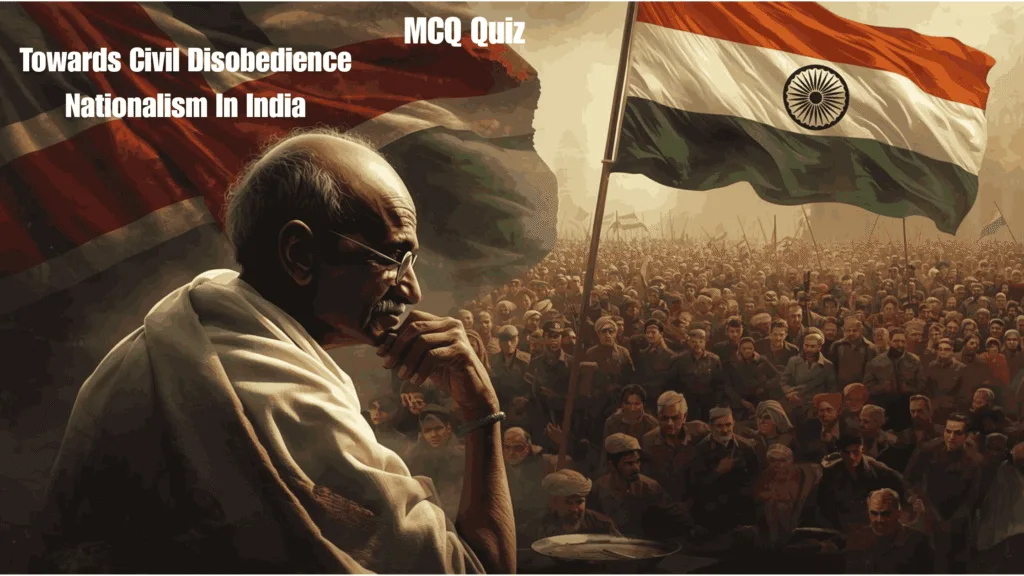
Leave a Comment